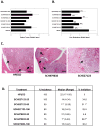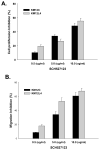Small molecule antagonists for CXCR2 and CXCR1 inhibit human colon cancer liver metastases
- PMID: 21035946
- PMCID: PMC2994987
- DOI: 10.1016/j.canlet.2010.10.004
Small molecule antagonists for CXCR2 and CXCR1 inhibit human colon cancer liver metastases
Abstract
CXCR1 and CXCR2 are G-protein coupled receptors, that have been shown to play important role in tumor growth and metastasis, and are prime targets for the development of novel therapeutics. Here, we report that targeting CXCR2 and CXCR1 activity using orally active small molecule antagonist (SCH-527123, SCH-479833) inhibits human colon cancer liver metastasis mediated by decreased neovascularization and enhanced malignant cell apoptosis. There were no differences in primary tumor growth. These studies demonstrate the important role of CXCR2/1 in colon cancer metastasis and that inhibition of CXCR2 and CXCR1, small molecule antagonists provides a novel therapeutic strategy.
Copyright © 2010 Elsevier Ireland Ltd. All rights reserved.
Conflict of interest statement
None Declared
Figures






Similar articles
-
A small-molecule antagonist of CXCR1 and CXCR2 inhibits cell proliferation, migration and invasion in melanoma via PI3K/AKT pathway.Med Clin (Barc). 2019 Jun 7;152(11):425-430. doi: 10.1016/j.medcli.2018.08.006. Epub 2018 Oct 16. Med Clin (Barc). 2019. PMID: 30340844 English, Spanish.
-
Small-molecule antagonists for CXCR2 and CXCR1 inhibit human melanoma growth by decreasing tumor cell proliferation, survival, and angiogenesis.Clin Cancer Res. 2009 Apr 1;15(7):2380-6. doi: 10.1158/1078-0432.CCR-08-2387. Epub 2009 Mar 17. Clin Cancer Res. 2009. PMID: 19293256 Free PMC article.
-
The CXCR2 antagonist, SCH-527123, shows antitumor activity and sensitizes cells to oxaliplatin in preclinical colon cancer models.Mol Cancer Ther. 2012 Jun;11(6):1353-64. doi: 10.1158/1535-7163.MCT-11-0915. Epub 2012 Mar 5. Mol Cancer Ther. 2012. PMID: 22391039
-
Combined anti CXC receptors 1 and 2 therapy is a promising anti-inflammatory treatment for respiratory diseases by reducing neutrophil migration and activation.Pulm Pharmacol Ther. 2015 Oct;34:37-45. doi: 10.1016/j.pupt.2015.08.002. Epub 2015 Aug 10. Pulm Pharmacol Ther. 2015. PMID: 26271598 Review.
-
Targeting CXCR1/CXCR2 receptor antagonism in malignant melanoma.Expert Opin Ther Targets. 2010 Apr;14(4):435-42. doi: 10.1517/14728221003652471. Expert Opin Ther Targets. 2010. PMID: 20230195 Free PMC article. Review.
Cited by
-
The Role of Chemokines in Promoting Colorectal Cancer Invasion/Metastasis.Int J Mol Sci. 2016 Apr 28;17(5):643. doi: 10.3390/ijms17050643. Int J Mol Sci. 2016. PMID: 27136535 Free PMC article. Review.
-
Chemokine-Derived Peptides: Novel Antimicrobial and Antineoplasic Agents.Int J Mol Sci. 2015 Jun 8;16(6):12958-85. doi: 10.3390/ijms160612958. Int J Mol Sci. 2015. PMID: 26062132 Free PMC article. Review.
-
Boronic acid-containing aminopyridine- and aminopyrimidinecarboxamide CXCR1/2 antagonists: Optimization of aqueous solubility and oral bioavailability.Bioorg Med Chem Lett. 2015 Sep 15;25(18):3793-7. doi: 10.1016/j.bmcl.2015.07.090. Epub 2015 Jul 30. Bioorg Med Chem Lett. 2015. PMID: 26248802 Free PMC article.
-
Identification of key genes and pathways of diagnosis and prognosis in cervical cancer by bioinformatics analysis.Mol Genet Genomic Med. 2020 Jun;8(6):e1200. doi: 10.1002/mgg3.1200. Epub 2020 Mar 17. Mol Genet Genomic Med. 2020. PMID: 32181600 Free PMC article.
-
Identification of the interleukin-8 (CXCL-8) pathway in feline oral squamous cell carcinoma - A pilot study.Can J Vet Res. 2022 Jan;86(1):13-19. Can J Vet Res. 2022. PMID: 34975217 Free PMC article.
References
-
- Jemal A, Siegel R, Xu J, Ward E. Cancer Statistics. CA Cancer J Clin. 2010:2010. - PubMed
-
- Li A, Varney ML, Singh RK. Expression of interleukin 8 and its receptors in human colon carcinoma cells with different metastatic potentials. Clin Cancer Res. 2001;7:3298–3304. - PubMed
-
- Ruffini PA, Morandi P, Cabioglu N, Altundag K, Cristofanilli M. Manipulating the chemokine-chemokine receptor network to treat cancer. Cancer. 2007;109:2392–2404. - PubMed
-
- Matsushima K, Oppenheim JJ. Interleukin 8 and MCAF: novel inflammatory cytokines inducible by IL 1 and TNF. Cytokine. 1989;1:2–13. - PubMed
-
- Rossi D, Zlotnik A. The biology of chemokines and their receptors. Annu Rev Immunol. 2000;18:217–242. - PubMed
Publication types
MeSH terms
Substances
Grants and funding
LinkOut - more resources
Full Text Sources
Other Literature Sources
Medical
Miscellaneous

